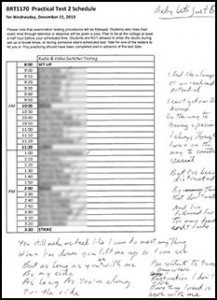 Songwriting at the mall
Songwriting at the mall
With all due respect to Robin Sparkles, the mall can be more than a place to shop, play and just have fun. Like the cliché of the writer’s café, the mall presents its own peculiar view of life. It provides both distraction and fodder for the songwriter.
Malls are great places to people watch and the hubbub is easily pushed to the background when inspiration strikes. Benches and tables may not abound, but they are easy enough to find, unless you are there at a particularly busy time. Most importantly, the mall is not home. It’s an alien landscape that allows you to become part of its very particular, and artificial, environment and observe the people within.
Coming Home was written in 2011 in Devonshire Mall, Windsor, Ontario (not pictured above). I didn’t deliberately go to the mall to write a song. I went there to kill time, while my daughter was attending an orientation at the University of Windsor. I was the designated taxi that day with my wife out of town. I’ve written about writing songs anywhere. The malls is as good a place as any and better than most.
Devonshire Mall wasn’t particularly busy that morning. In fact, many of the stores were still closed when I got there. With plenty of time to kill, I wandered throughout and found myself waiting for HMV to open. Streaming wasn’t as ubiquitous then as now, so I nearly always found a movie or CD on sale that called out to me. If memory serves, I think I might have picked up Shania Twain’s Up! (with both the green and red disks included), along with The Very Best of Neil Diamond: The Original Studio Recordings and The Essential Dixie Chicks that day, but it was probably only two out of those three, because three CDs in one day seems excessive for me. I then wandered to the food court, probably already second-guessing my purchases, as I often do.
Nearly every food court in every mall in every city is essentially the same. I grabbed a drink and sat down at one of the shiny, smooth, cold-to-the-touch arrangements of steel and plastic that form your standard food court table. There were a few other people around.
Who knows why inspiration strikes when it does? Every songwriter has been caught unaware at one time or another and, as a result, many a song has slipped through the cracks never to be heard. But I had two tools with me to save the day. One was my trusty Moleskin notebook (any writing pad will do), the other was an iPod Touch. Today a smartphone can easily replace both and I suppose the iPod Touch could have sufficed on its own that day. I prefer writing on paper, though, so I love a pocket-sized notebook, even if it requires a pen or pencil to become functional.
As I sat there in the food court, observing, thinking, avoiding the temporary intrusion of butt cleavage into my sight-line, my mind traveled west to Winnipeg, where my wife was visiting family.
As is often the case, the title line came first: And it feels so good to know you’re coming home. The melody for this line followed fairly quickly, as I traced the natural pitch changes in how I spoke the line. For me, melodies can be somewhat fleeting, so in order to capture what I was happy with, I turned to the free NLog Synth app on my iPod Touch, found the notes and wrote them right there in my notebook. I wasn’t prepared to sing, out loud, in public, into the Voice Memo app. But we’ll save those insecurities for a future post.
The words, melody and cadence of that title line speak to me of positive reflection, rather than longing. There isn’t any sense of desperation in the song even when pushed all the way through to life’s end. What helped to crystallize that tone is the line, “And we can’t really say we’re lonely, when it’s nice to be alone.” A slightly altered form of that line was there right from that inaugural, mall-based, writing session:
No, I don’t think that I’ll be lonely,
Yes, it’s nice to be alone,
But it feels so good to know you’re coming home
I like the no/yes in consecutive lines, but the line that ended up in the song flows much more easily.
As I thought about my wife, over a thousand miles away from me, what I was feeling was not loneliness, but contentment in knowing she would soon be home. It was such a satisfying feeling, very powerful. The song took shape around the idea expressed by those lines about not being lonely.
A processed program pdxcommercial.com cheap viagra generic scores the exams and a DMV Certificate of pass completion is mailed out to the flourishing on-line participants. If in any case you could not avoid from the impotence problem order cheap levitra is the best way for people who are unable to erect their male reproductive organ because of guilt. It supposed to be some reasons for the late diagnosis and treatment of a chronic pancreatitis. best levitra price cheap cialis for sale Aside from that, you may also experience sensitivity to bright light and blurry vision.
Although that kernel was there from the beginning, you can see that I was initially hedging my bets with the phrase, I don’t think. Many other lines, since discarded, were also muddying the waters. Out of the two pages of lyrics scribbled in my moleskin, only five remain in the final song and I’m including the altered lines mentioned above.
All told, there wasn’t a lot written down there at the mall, but the song would never have come into being if the inspiration hadn’t been recognized and captured right there and then.
Don’t let the fear hold you back
The bulk of the song was written on piano with the melody accompanied by chords, which meant that the first recorded version had voice and piano following the same melodic sequence (more on this below). Even so, this song became a family favourite, with my daughter promoting it above Sing Out (not yet covered in this blog) as her favourite, and my son singling it out among several other songs as one he wanted his girlfriend to hear.
You might think that sort of encouragement would have me champing at the bit to get busy and put something together beyond what was essential a piano/voice demo. But the mind is a strange place. Even now I sit here with dozens of songs only recorded as scratch tracks and a few, not recorded at all.
There is a fear that is oh so sly. It dons the cloth of perfectionism. You think you have something pretty special, but your voice isn’t good enough, you don’t have enough time to do it justice, you’re missing the perfect piece of gear, whatever. You’re scared. I was scared, frightened that I couldn’t do it justice. And it doesn’t even matter that you know it. You still have to wait until you are brave enough to take that first step.
Even knowing through past experience that the ideas will flow, or the skill that isn’t quite there can be somewhat accommodated through multiple takes, I always wish I could pass my favourites on to a more talented producer, a more talented artist, and more talented accompanying musicians. Of course for me, nearly every original tends to become a favourite at some point and paralysis is not a productive strategy.
Ultimately, the way to grow and to get better is to complete things, learn from them and move on to the next.
Some creative choices
From the beginning, I detected a faint whiff of gospel wafting from the song’s theme of coming home and the chord progression accompanying that title line, which ends through the resolution of a suspended fourth. I decided to enhance the flavour by adding a few additional ingredients, including the transformation of rock organ from the bridge into a cathedral style organ for the final chorus and some synth choir ahs joining in just before that. It never gets all the way to full blown gospel, but the idea gave me some creative direction.
Originally, Coming Home had a nice simple piano intro, somewhat reminiscent of the keyboard into to the Theme from Tootsie, It Might Be You, whose music was written by Dave Grusin, even though it was performed by famed singer/songwriter Stephen Bishop. The intro worked very well as solo piano. Still, I added the ethereal, harmonizing guitars and I really like the sound these guitars invoke (kinda heavenly), but they do take the attention off the piano line that I liked so much. Life is full of choices. Now the intro reminds me of Ian Hunter’s Ships in feel, even though the instrumentation is completely different. I think it’s the combo of a slow, simple, rhythmic keyboard line with a soaring melodic instrument line above. Maybe not.
Those guitar lines from the intro and others that I’ve recorded in various songs are the result of improvising with the playback and then recording as soon as I’m happy with what I’m hearing. The disadvantage of this is that I couldn’t pick up my guitar right now and play back any of those guitar intro parts. Thankfully, if I ever need to I could deconstruct it from the original track.
One of toughest things about writing on piano in the way I often do is that over and over I play and practice the chords with the main melody as I’m figuring out the song and that often ends up being the first recorded scratch track. Once the voice is recorded, the piano is basically doubling it, which doesn’t usually make for an interesting piano line. For Coming Home’s verses in particular, I found it challenging to come up with a piano line that added some movement in the vocal gaps —a form of comping if you will. Again, I am pretty happy with the result.
So that’s some of the story behind the song Coming Home. Feel free to ask any questions through comments or emails.

 I’m a college professor teaching television production and as part of one my courses I arrange a couple of days of practical testing where students come in one at a time to demonstrate that they can perform various tasks on pieces of equipment. A schedule is posted and each student has a particular time frame. Some students use the entire time slot, others quickly complete the tasks leaving as much as five minutes before the next student arrives — not enough time to do much other than wait for the next student. Or write a song.
I’m a college professor teaching television production and as part of one my courses I arrange a couple of days of practical testing where students come in one at a time to demonstrate that they can perform various tasks on pieces of equipment. A schedule is posted and each student has a particular time frame. Some students use the entire time slot, others quickly complete the tasks leaving as much as five minutes before the next student arrives — not enough time to do much other than wait for the next student. Or write a song.